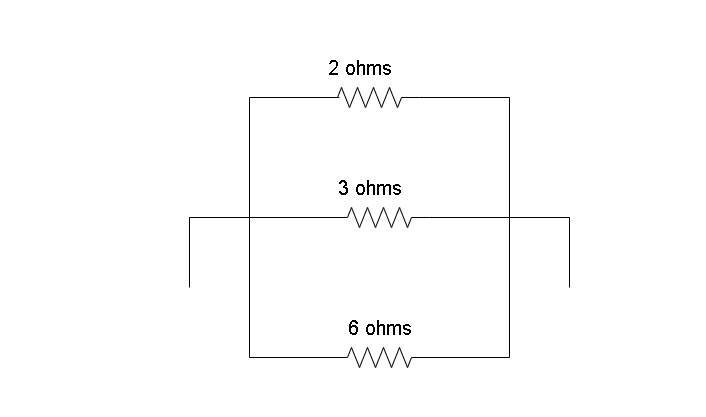Answer
64.8k+ views
Hint: Two types of circuits are known-one is series circuit and other one is parallel circuit. In a parallel circuit combination of resistors, the ends of each of the resistances are connected to the same common point. . It is to be noted that if more resistances are connected in parallel, the effective resistance of the circuit will decrease and current will increase. But in series circuits if more resistances are connected then effective resistance will increase and current will decrease.
Complete step by step solution:
The first thing to understand about parallel combination of circuits is that the voltage is equal across all three resistances in the circuit. This is because voltage measured between common points must always be the same at any given time. The reason is that the value of resistance in parallel combination is negligible or is less than the individual resistance. But the value of current is different for all the resistances. The total current is equal to the sum of current through each individual resistance.
Given three resistances are
\[{R_1} = 2\Omega \]
\[{R_2} = 3\Omega \]
\[{R_3} = 6\Omega \]

Formula used to calculate equivalent resistance for the parallel combination of resistances is:
\[\Rightarrow \dfrac{1}{R} = \dfrac{1}{{{R_1}}} + \dfrac{1}{{{R_2}}} + \dfrac{1}{{{R_3}}}\]
Substituting given values and solving, above equation
\[\Rightarrow \dfrac{1}{R} = \dfrac{1}{2} + \dfrac{1}{3} + \dfrac{1}{6}\]
\[\Rightarrow \dfrac{1}{R} = \dfrac{{3 + 2 + 1}}{6}\]
\[\Rightarrow \dfrac{1}{R} = \dfrac{6}{6}\]
\[\Rightarrow \dfrac{1}{R} = 1\Omega \]
\[\Rightarrow R = 1\Omega \]
It is mandatory to inverse the value of ‘R’ in the denominator while finding the equivalent resistance in parallel combination. The value of equivalent resistance of three resistances connected in parallel is \[ 1\Omega \]. In case if a circuit is connected in parallel the appliances work efficiently. But if one of the appliances in this circuit is fused, the current continues to flow from the other.
Note: The parallel combination works in accordance with Ohm’s Law \[(V = IR)\]. But since current varies, Ohm’s law is applied to find the value of current I for all the resistances. Because resistance and voltage will already be given. The value of individual current can be known by using formula \[I = \dfrac{V}{R}\].
Complete step by step solution:
The first thing to understand about parallel combination of circuits is that the voltage is equal across all three resistances in the circuit. This is because voltage measured between common points must always be the same at any given time. The reason is that the value of resistance in parallel combination is negligible or is less than the individual resistance. But the value of current is different for all the resistances. The total current is equal to the sum of current through each individual resistance.
Given three resistances are
\[{R_1} = 2\Omega \]
\[{R_2} = 3\Omega \]
\[{R_3} = 6\Omega \]

Formula used to calculate equivalent resistance for the parallel combination of resistances is:
\[\Rightarrow \dfrac{1}{R} = \dfrac{1}{{{R_1}}} + \dfrac{1}{{{R_2}}} + \dfrac{1}{{{R_3}}}\]
Substituting given values and solving, above equation
\[\Rightarrow \dfrac{1}{R} = \dfrac{1}{2} + \dfrac{1}{3} + \dfrac{1}{6}\]
\[\Rightarrow \dfrac{1}{R} = \dfrac{{3 + 2 + 1}}{6}\]
\[\Rightarrow \dfrac{1}{R} = \dfrac{6}{6}\]
\[\Rightarrow \dfrac{1}{R} = 1\Omega \]
\[\Rightarrow R = 1\Omega \]
It is mandatory to inverse the value of ‘R’ in the denominator while finding the equivalent resistance in parallel combination. The value of equivalent resistance of three resistances connected in parallel is \[ 1\Omega \]. In case if a circuit is connected in parallel the appliances work efficiently. But if one of the appliances in this circuit is fused, the current continues to flow from the other.
Note: The parallel combination works in accordance with Ohm’s Law \[(V = IR)\]. But since current varies, Ohm’s law is applied to find the value of current I for all the resistances. Because resistance and voltage will already be given. The value of individual current can be known by using formula \[I = \dfrac{V}{R}\].
Recently Updated Pages
Write a composition in approximately 450 500 words class 10 english JEE_Main

Arrange the sentences P Q R between S1 and S5 such class 10 english JEE_Main

What is the common property of the oxides CONO and class 10 chemistry JEE_Main

What happens when dilute hydrochloric acid is added class 10 chemistry JEE_Main

If four points A63B 35C4 2 and Dx3x are given in such class 10 maths JEE_Main

The area of square inscribed in a circle of diameter class 10 maths JEE_Main

Other Pages
A boat takes 2 hours to go 8 km and come back to a class 11 physics JEE_Main

Electric field due to uniformly charged sphere class 12 physics JEE_Main

In the ground state an element has 13 electrons in class 11 chemistry JEE_Main

According to classical free electron theory A There class 11 physics JEE_Main

Differentiate between homogeneous and heterogeneous class 12 chemistry JEE_Main

Excluding stoppages the speed of a bus is 54 kmph and class 11 maths JEE_Main



